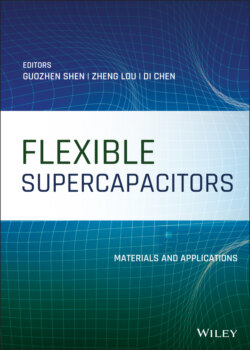Читать книгу Flexible Supercapacitors - Группа авторов - Страница 16
1.3.1.3 Transition Metal Nitride Anodes
ОглавлениеOwing to the high conductivity and transition metal sites with multiple valence states, transition metal nitrides are emerging as promising pseudocapacitive anode materials with fast and reversible redox reactions. Many transition metal nitrides have been exploited for AFSCs, such as titanium nitride, vanadium nitride, tungsten oxynitride, iron nitride, etc., with high performances comparable to transition metal oxide anodes [91,99–101]. For instance, Fan's group successfully fabricated an all‐metal nitrides solid‐state asymmetric SC, where the titanium nitride (TiN) cathode and iron nitride (Fe2N) anode were grown on CC‐loaded graphene nanosheets (GNS) using atomic layered deposition followed by calcination under ammonia atmosphere (Figure 1.6a). The porous configuration of TiN and homogeneous distribution of Fe2N nanoparticles contribute to the extraordinary cycling durability (≈98% capacity retention after 20 000 cycles) of the fabricated quasi‐solid‐state AFSC device using PVA/LiCl polymer gel as neutral electrolyte (Figure 1.6b). The AFSC device achieved a maximum energy density of 0.61 mWh cm−3 and a maximum power density of 422.7 mW cm−3, which were substantially higher than those of transition‐metal‐nitride‐based SCs and PVA‐based solid‐state SCs (Figure 1.6c). Lu's group has reported various AFSCs using CC‐loaded transition metal nitride anodes in recent years. For example, they used neutral PVA/LiCl polymer gel electrolyte to effectively stabilize porous VN NWs anode, and paired it with VOx NWs cathode to assemble a stable and high‐performance quasi‐solid‐state AFSC device with a high output voltage of 1.8 V [91]. Furthermore, the VOx//VN‐AFSC device was able to deliver an impressive volumetric capacitance of 1.35 F cm−3, a highest energy density of 0.61mWh cm−3 and extraordinary cycling stability with 12.5% loss of capacitance after 10 000 cycles. They also prepared holey tungsten oxynitride (WON) nanowires on CC through the annealing of WO3 precursor nanowires in ammonia atmosphere [100]. The as‐fabricated AFSC device with WON NWs anode and MnO2 cathode could deliver a high working voltage of 1.8 V and volumetric capacitance of 2.73 F cm−3. The maximum energy density of MnO2//WON AFSC device was 1.27 mWh cm−3 at a power density of 0.62 W cm−3, which has transcended many reported AFSC devices.
Figure 1.5 (a) Schematic diagram illustrating the synthesis procedure of MnO2 NWs and Fe2O3 NTs on carbon cloth. (b) Schematic sketch illustrating the designed asymmetric supercapacitor device. (c) CV curves of the assembled solid‐state AFSC device collected in different scan voltage windows. (d) Ragone plots of the solid‐state AFSC device. Inset shows a blue LED powered by the tandem AFSC devices.
Source: Reproduced with permission [54]. © 2014, American Chemical Society.
Figure 1.6 (a) Schematics of the fabrication processes of metal nitride cathode and anode materials. (b) Cycling performance of full device at 4 A g−1 in 20 000 cycles with different bending situations. (c) Ragone plots of quasi‐solid‐state TiN‐Fe2N AFSC in comparison with other PVA‐based solid electrolyte SFSCs and AFSCs. Inset: pink and white LEDs in parallel are lit up by two full devices in tandem.
Source: Reproduced with permission [101]. © 2015, Wiley‐VCH.
